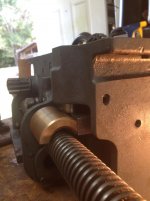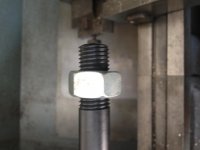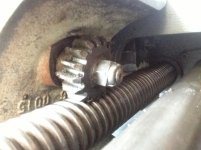tarawa
Aluminum
- Joined
- Jan 8, 2008
- Location
- Loxahatchee, Florida
I recently purchased a 15 x 30 Colchester Triumph lathe which needed a half nut. Being a cheap hobbiest and not wanting to spend ~$700.00 for a new one, I decided to make my own which I must say turned out very well. Since I could use taps and dies to do most of my threading, I don't really cut many threads on the lathe. I decided to try out my new half nut last night and set up to cut a 1/2 -13 thread on some brass round stock that I had laying around. It was a disater of a thread when I was finished. Nothing seemed to work as it should....except my new half nut.
Cutting an odd size thread, the thread chase dial should read any whole number...correct? I had to land on the same number (4) to have the thread chase correctly.
I found a thread chase dial in the drawer of the lathe and this is what I used and the attachment holes dont line up with the dial.
The top pivot hole seems to be correct for the allignment, but the bottom hole doesnt. I attached it with one bolt.
1) Where should the gear of the thread chase dial intersect the leadscrew?
2) How many teeth are on the gear of the thread chase dial when the lead screw is 1 1/4 x 4TPI
3) Why doesn't the Colchester Triumph have the compound marked in degrees? Real PITA
4) What caused my threads to look like a saw tooth? Compound angle off slightly or incorrect?
Cutting an odd size thread, the thread chase dial should read any whole number...correct? I had to land on the same number (4) to have the thread chase correctly.
I found a thread chase dial in the drawer of the lathe and this is what I used and the attachment holes dont line up with the dial.
The top pivot hole seems to be correct for the allignment, but the bottom hole doesnt. I attached it with one bolt.
1) Where should the gear of the thread chase dial intersect the leadscrew?
2) How many teeth are on the gear of the thread chase dial when the lead screw is 1 1/4 x 4TPI
3) Why doesn't the Colchester Triumph have the compound marked in degrees? Real PITA
4) What caused my threads to look like a saw tooth? Compound angle off slightly or incorrect?





